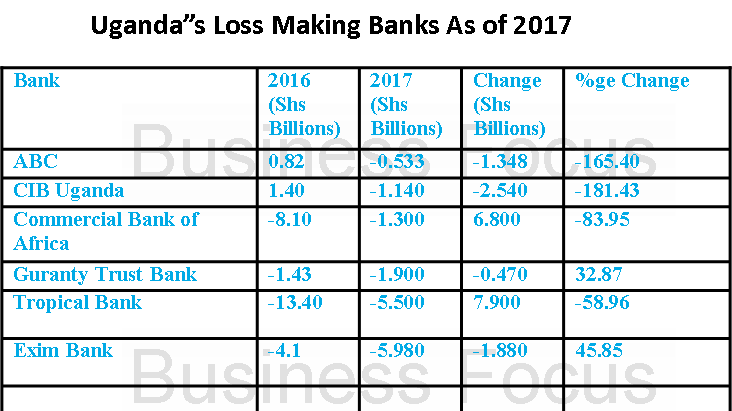Bank of Uganda (BoU) has warned that six banks that made losses in 2017 ‘risk facing liquidity issues’, a thing that might affect their growth.
This revelation is contained in BoU’s Annual Supervision Report for 2017 released by Governor Prof. Emmanuel Tumusiime-Mutebile recently.
“Six banks, with a combined 4.7 percent share of the banking industry total assets, made losses in 2017. This poses a risk to their ability to conserve capital in order to support the implementation of their business models,” the report reads in part.
It adds: “Nonetheless, all banks remained adequately capitalised during the year.”
At end of 2017, there were 24 commercial banks in operation.
Although the report doesn’t mention the six banks, Business Focus can reliably report that loss making banks as of December 31, 2017 include Exim Bank, Guaranty Trust Bank, Commercial Bank of Africa, Tropical Bank, Cairo International Bank and ABC Capital.

Exim Bank that acquired Imperial Bank a few years ago recorded a net loss of Shs5.98bn in 2017, up from 4.1bn loss recorded in 2016.
The bank hasn’t been performing well since it joined the Ugandan market in 2011. The rise in losses could be attributed to the bad loans written off that increased to Shs14.69bn in 2017, up from Shs1.4bn recorded a year earlier.
Tropical Bank made a loss of Shs5.5bn in 2017, down from a loss Shs13.4bn.
According to a critical analysis of the figures, Tropical’s loss can be attributed to high NPLs and bad loans written off.
NPLs reduced to Shs28.7bn in 2017 from Shs38.27bn in 2016, while bad loans written off increased to Shs12.06bn in 2017 from Shs11.79bn in 2016.
Guaranty Trust Bank (GTBank) made a loss of Shs1.9bn in 2017, up from Shs1.43bn loss in 2016. The loss could be attributed to high NPLs, hitting Shs4bn in 2017, up from Shs2.85bn in 2016.
The bank recently appointed Lekan Sanusi as its Managing Director, replacing Olufemi Omotoso, who returned to the Group’s head offices in Nigeria.
It should be noted that GTBank entered the East African market in 2014 after acquiring 70 percent in Fina Bank Group’s operations in Kenya, Uganda and Rwanda.
Commercial Bank of Africa (CBA) has also found it hard to hit the ground running after re-joining the Ugandan market in 2014 (It had exited the market in 1969 due to political instability). The bank has been recording losses since inception. In 2017, it made a loss of Shs1.3bn, down from Shs8.1bn loss in 2016. Like other loss making banks, CBA’s loss is certainly due to NPLs that increased to Shs7.8bn from Shs6.19bn in 2016.
However, other key performance parameters are positive for CBA that is headed by Samuel Odeke as Managing Director.
Troubled Cairo International Bank (CBA) that had made a net profit of Shs1.4bn in 2016 bounced back in the red chart, registering a loss of Shs1.14bn in 2017. The loss is attributed to high NPLs and bad loans written off; NPLs increased to Shs2.5bn from Shs1.67bn, while bad loans written off increased to Shs450.5m in 2017, from Shs235.7m in 2016.
ABC Capital recorded Shs533m loss in 2017, from Shs815m net profit registered in 2016.
BoU report notes that during 2017, the Central Bank conducted on-site examinations of all commercial banks using the risk-based supervision methodology, with a special emphasis on areas that pose the highest risk to financial institutions.
“For a number of banks, there were weaknesses in the composition of board committees, succession planning for board members and senior management, and delays in addressing vacancies in key positions of banks’ organisational structures.
For regional and international banks, the key concerns related to risks that emanate from overreliance on the parent companies for operational support,” the report says.
It adds: “With regard to strategic risk, the main findings were related to unrealistic assumptions underlying the strategic plans and lapses in the implementation of strategic initiatives. While there were no breaches of credit concentration regulations, lapses were noted in the credit underwriting processes. However, the ratio of non-performing loans (NPLs) to total loans improved during 2017.”
The report adds that there were some concerns pertaining to some banks’ information communication technology (ICT) infrastructure.
“Some banks’ core banking systems were obsolete, with weak embedded IT controls and unable to adequately support operations, leading to routine operational challenges.
Moreover, some banks’ systems could not adequately assess money laundering/terrorism- financing risks, and support robust financial reporting,” the report adds.
The banking sector’s profitability improved significantly during 2017, the report says.
The net after-tax profits more than doubled from Ush.302.1 billion for the year 2016 to Ush.672.9 billion for the year 2017.






